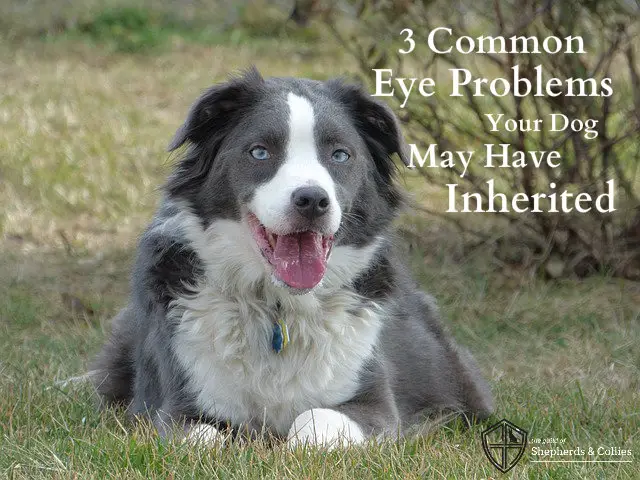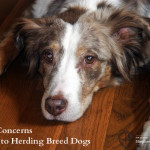Three Common Eye Problems Your Dog May Have Inherited
Three Inherited Eye Problems in Herding Breeds
Good vision is important for all dogs, but especially so for high energy, active dogs like herding breeds and herding breed mixes. A blind dog can be a lovely family companion but would be very limited as a working dog or as a competition dog in many dog sports.
Inherited eye problems may appear right at birth (congenital) or may show up later in life. Some of these problems have a known pattern of inheritance. Others have a DNA test available to determine the genetic risk of a given dog. Responsible breeders do the testing, including periodic eye evaluations by a veterinary ophthalmologist as well as the DNA testing, to minimize the risk of producing a puppy with these defects. In general, carriers will not show the disease but can pass it on to offspring. They should only be bred with care and to dogs of totally normal inheritance.
Three of the common eye problems will be discussed here. While breed predilections will be noted, it is important to remember that these defects can show up in many dogs, including mixed breeds. Even with the same actual defect, different modes of inheritance and different responsible genes may be behind the defect in an individual dog.
PROGRESSIVE RETINAL ATROPHY
Progressive Retinal Atrophy or PRA involves a degeneration of the cells at the back of the eye. These cells normally take in visual images and then refer them to the brain for evaluation and classification. With advanced PRA, no information gets relayed back to the brain. PRA is not painful.
What families notice is a gradual loss of vision, starting with problems at night or in poor lighting. Your dog may stumble into objects or hesitate about doing stairs or coming through doorways. Onset tends to be slow and gradual, so it may be difficult to pick up initially. Some dogs will develop secondary “toxic” cataracts from oxidative damage to the eye. These can contribute to vision loss.
While there is no direct therapy for PRA, the use of specially designed antioxidant supplements can help delay total loss of vision. Early detection is important for supplements to help. No medications or supplements will cure PRA, however.
The age of onset of PRA varies both with the breed and with the exact genetic defect. Collies may develop one type of PRA as early as 6 to 8 months of age. In general, most cases of PRA show up at 6 to 8 years of age, however. With late onset PRA, many dogs have already been bred. For this reason, researchers are working to identify the genetic defects responsible for this problem and develop DNA tests so breeding stock can be tested early on.
DNA testing can be done very easily, even in young puppies – usually with a cheek swab. Doing a DNA test before breeding dogs is the best way to avoid this genetic problem. Many herding breeds are listed as potential test dogs for PRA. Some breeds have multiple DNA tests, such as the Australian Cattle Dog. In that case, two different defects have been identified in Australian Cattle Dogs which can lead to PRA and eventual blindness.
Australian Shepherds (all sizes), Cardigan Welsh Corgis, Collies, English Shepherds, Entlebucher Mountain Dogs and Shetland Sheepdogs are among the breeds where there is a DNA test.
PRA seems to be inherited as an autosomal recessive. That means it can affect both male and female dogs and that a parent who appears normal may carry the defective gene. Both parents have to contribute the bad gene for a puppy to be affected.
CATARACTS
All cataracts involve the lens of the eye. A disruption in lens fibers allows extra fluid and protein into the lens. This clouds the lens, interfering with clear vision. The size and location of a cataract will determine how much vision is affected. In some cases it is minimal while in other cases, the affected dog may be blind.
Dogs can be born with cataracts. This may result from toxin exposures or infections but may also be genetic. In herding breed dogs, most juvenile cataracts don’t show up until at least a couple of weeks after birth. In fact, most don’t become apparent until 6 months to 6 years of age. German Shepherd Dogs are prone to juvenile cataracts which may show up as early as 8 weeks of age. There is no DNA test for the problem at this time.
Many older dogs will develop cataracts secondary to other problems such as diabetes. While there may be a genetic predisposition in these cases, inheritance is not clear at all. Depending on when the cataracts do show up, you will notice changes in your dog’s behavior. He may be hesitant to enter dark areas or blunder into furniture, if you have rearranged a room.
Read about Acquired Eye Problems in Your Herding Breed
Hereditary cataracts tend to show up in both eyes since the genetic material is the same for both. One eye may develop a cataract faster than the other eye however, so the defect may not show up at the exact same time in both eyes.
The inheritance of cataract genes can vary. One breed in which inheritance has been extensively studied is the Australian Shepherd. In Aussies, cataracts tend to be dominant with incomplete penetrance. Dominant means that a dog with only one copy of the bad gene could develop cataracts. Incomplete penetrance means that there are influencing factors, possibly environmental or possibly modifier genes, that may cause the cataracts to develop or prevent them from developing. Dogs with only one copy of the gene may never develop cataracts, but dogs with two copies of the deleterious gene tend to get vision-affecting cataracts. Aussies can be tested for the HSF4 mutation. This mutation is associated with about 2/3 of all Aussie cataracts and about a quarter of the Australian Shepherd population carries this gene. With DNA testing available, breeders can plan breedings to minimize the risk of producing a puppy with vision-affecting cataracts.
COLLIE EYE ANOMALY OR CEA
This eye problem is a bit of a misnomer as it can and does appear in more breeds than just Rough and Smooth Collies. The condition has been noted in Border Collies, Bearded Collies, Australian Shepherds (all sizes), Shetland Sheepdogs and Lancashire Heelers. You may see the problem listed as CEA/CH with the CH standing for choroidal hypoplasia as well. In addition, the problems of retinal detachment and optic nerve coloboma ( a “pit” in the nerve) are often associated with the CEA.
CEA/CH affects the choroid of the eye – a layer of tissue in the back of the eye by the retina. The choroid cells are disrupted and information from visual images is not relayed to the brain – as with PRA. This is not a progressive disease; what is present at birth will essentially stay the same. Experienced veterinary ophthalmologists can pick this condition up on an eye exam as early as 5 to 8 weeks of age. In fact, mild cases may be “masked” by normal pigment development in that area of the eye by 12 weeks of age, so early eye exams are important for the potentially affected breeds.
Since CEA/CH is present at birth, you will not notice changes in a dog’s vision. Instead, you might notice the dog having trouble negotiating in new areas. Looking at a litter, some puppies may appear hesitant in their movements.
It is not a painful problem and is inherited as a recessive, so the parent dogs may appear normal but pass this defect on to their pups. Both parents must contribute for a puppy to be affected. The incidence of carriers is extremely high in the Collie breed, so breeders need to test all breeding stock, plan matings carefully and then test all puppies early on, as well as doing eye exams on very young pups.
Dogs with a mild form of this problem will often have basically normal vision throughout life. Severely affected dogs can be blind. Both mild and severe cases show the same genetic defect on DNA testing. Therefore, there must be modifier genes or environmental influences coming into play. Those have not been identified at this time.
There are other eye problems which can show up in herding breed dogs and herding breed mixes. These are three of the major defects which can be identified both via ophthalmologic exams by veterinary ophthalmologists and by DNA testing. It is certainly worthwhile to do these tests on any dog you add to your family and absolutely important for any dog you plan to breed. Hopefully the results will be negative for the defect and you can look forward to a full and active life for your dog!
Article By:
Deb M. Eldredge, DVM








